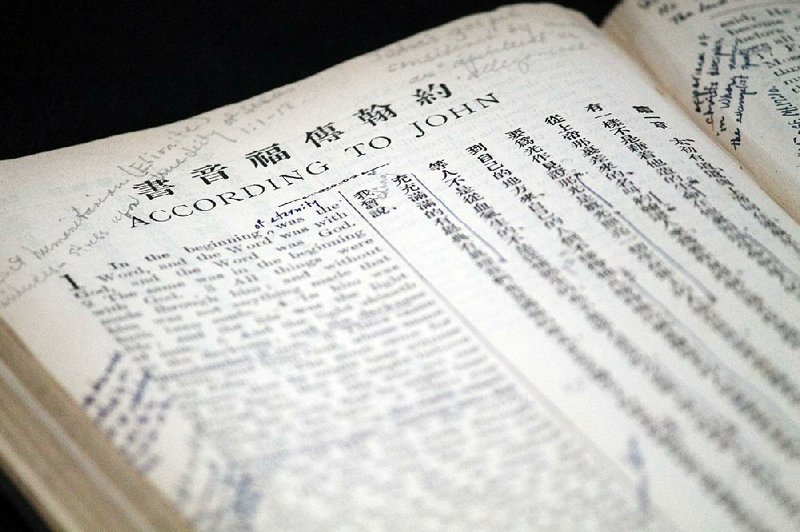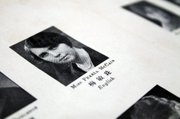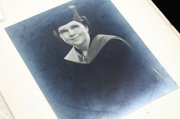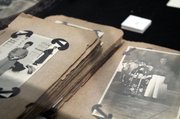A Chinese-English Bible that belonged to United Methodist missionary Pearle McCain is splashed throughout with notes in the margins and additions to the text where she thought it necessary.
As a result, her copy of the Gospel of John now begins: "In the beginning (of eternity) was the Word ..."
It's a testament to how McCain, a Hazen native who served in China and Japan for most of her adult life, was no stranger to making her mark.
McCain's Bible, along with more than 30 items and artifacts from the United Methodist missionary's life and work, are part of "Pearle McCain: Faith in Action," an exhibit opening Sunday at Little Rock's United Methodist Museum of the Arkansas Conference.
The opening coincides with Heritage Sunday, which falls on the third Sunday of May each year and is a day United Methodists set aside for remembering the church's legacy.
Martha Sowell, a member of the museum's board of directors who also serves on the Arkansas Conference Commission of Archives and History, emphasized the importance of the church's history within the faith, noting that it has archives at the state and national levels. The museum's exhibit is an example of United Methodist history on the state level, along with the Conference Archives in the library at Hendrix College in Conway, whose website lists McCain as a recipient of the college's Distinguished Alumni Award.
Born in 1902, McCain -- who graduated from Galloway College in Searcy (which later merged with Hendrix College) and Scarritt College for Christian Workers in Nashville, Tenn. -- saw China for the first time in 1929 after being assigned to serve there by the Methodist board of missions.
It was the beginning of 40 years McCain would spend as a teacher and later an administrator in China and Japan.
According to Shakeelah Rahmaan, director and curator of the museum housed in Little Rock's First United Methodist Church, McCain had given a plain explanation for why she spent most of her life serving others in a place far away from everything familiar.
It was just something she wanted to do.
"[McCain] gave a pretty basic reason, and she had the support of her family," Rahmaan said. "They never tried to stop her or discourage her."
China and Japan had always been of interest to McCain, Rahmaan said, and mission work became a way to combine her interest with carrying out her faith.
The exhibit would not have existed if Jason Littleton, an intern at the museum in conjunction with the University of Arkansas at Little Rock's public history master's degree program, had not decided to open a box of miscellaneous items he had found in the museum's storage room in the fall of 2015.
Inside were artifacts from McCain's life, including an oral history interview. Museum officials didn't know they possessed the items until Littleton's discovery, after which followed a proposal for an exhibit.
Two of the three diaries McCain is known to have kept during her life will be part of the exhibit, and part of Littleton's undertaking at the museum was to transcribe the diary that detailed events in McCain's life from 1935-38. In the diary, which was donated by her now deceased niece, Anne Misenhimer Crofoot Queen, McCain chronicled events including Japan's invasion of China in July 1937. While many U.S. missionaries returned to the States, she chose to stay and was even detained in Shanghai for several months when Japanese forces took control of China's public transportation.
She expressed frustration in one entry from Aug. 13, 1938: "After one year of the undeclared war -- what? As far as I can see the end is not in sight. Shanghai streets today practically deserted. Several 'guests' with bombs, etc. found in the settlement trying to make trouble -- anti-leaflets dropped from an airplane."
McCain returned to the United States in 1942, falling ill, recovering and then staying to earn a degree from Union Theological Seminary and a doctorate in education from Columbia University. In 1951 a board member of Seiwa College for Christian Workers in Japan invited McCain to teach at the school after reading her thesis, which focused on further developing a curriculum at a seminary in China.
McCain spent the next 20 years teaching at Seiwa and later served as a department chair before retiring to Little Rock in 1971 and becoming a member of Trinity United Methodist Church, also in Little Rock. She died in 1983.
Sowell recalled being among the families that drove McCain to church services at Trinity in her later years, as McCain did not own a car.
"It was our privilege to do [so]," said Sowell, who along with McCain had family who were attending Trinity.
Rahmaan, who is not Methodist, said that for those in the church the link to McCain is in the traits they share.
"Methodists are very open and they are accepting, and I feel like that's the connection right there," Rahmaan said. "You just think about her time, up to 2018, and if you research the figures that are important to [United Methodists], that's always what they're about -- trying to see who they can help."
Paul Brown, chairman of the museum's board of directors, said McCain's work was ecumenical and relevant and that Rahmaan and Littleton "have really been the magic to make this thing go ... it's taken a youthful injection of time and talent and people who really care about this to move this project forward."
Brown said it can be difficult to find an audience for church history.
"We're trying to enliven the concept [of church history] here with the real world of Pearle McCain and its relevance in today's world," Brown said. "[McCain's] such a strong person, and for young women in particular, I think she's inspirational, to know her story."
"Pearle McCain: Faith in Action" will be open from 9 a.m. to noon on Wednesdays and from 9 a.m. to 3 p.m. on Sundays through November 30.
Religion on 05/19/2018



